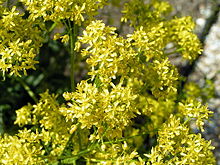Isatis: Difference between revisions
Material belongs in species article. |
No edit summary |
||
| Line 18: | Line 18: | ||
''Isatis glauca''<br/> |
''Isatis glauca''<br/> |
||
''[[Isatis tinctoria]]''<br/> |
''[[Isatis tinctoria]]''<br/> |
||
''Sameraria'' <br/> |
|||
''Pachypterygium'' |
|||
''Boreava'' |
|||
''Tauscheria'' |
|||
others (see text) |
others (see text) |
||
|}} |
|}} |
||
'''''Isatis''''' is a genus of about 30 species of [[angiosperms|flowering plant]]s in the family [[Brassicaceae]], native to the [[Mediterranean]] region east to central [[Asia]]. The genus includes [[woad]] (''Isatis tinctoria''). |
'''''Isatis''''' is a genus of about 30 species of [[angiosperms|flowering plant]]s in the family [[Brassicaceae]], native to the [[Mediterranean]] region east to central [[Asia]]. The genus includes [[woad]] (''Isatis tinctoria''). Due to their extremely variable morphology, the Asian species in particular are difficult to determine; the only reliable diagnostic feature is the [[ripe]] fruit. They are (usually) [[biennial]] or perennial [[herbaceous plant]]s, often bluish and hairless or downy hairy with the upright stem branched.<ref>H. Moazzeni et al .: Phylogeny of Isatis (Brassicaceae) and allied genera based on ITS sequences of nuclear ribosomal DNA and morphological characters. In: Flora (Elsevier) , Volume 205, 2010, pp. 337–343.</ref> |
||
==Description== |
|||
They are annual, biennial or perennial, branched herbs, usually [[Glabrousness (botany)|glabrous]] and [[glaucous]] except [[silicon]]. Basal leaves generally elliptic-oblong, [[sessile]]; sessile caulinary, rounded to oval-oblong. |
|||
The [[hermaphrodite]] flowers are fourfold double [[perianth]]. The four [[sepal]]s are ascending to upright. The four yellow to [[off-white]] or [[Lilac (color)|lilac]]-white petals are at least as long as the sepals. They have six [[stamen]]s with very small, egg-shaped or elongated-round anthers. There are [[nectar]] glands. [[Racemose]] is branched or paniculated, ebracted, inflorescence, often reaching lax and elongated in the fruit. |
|||
The fruit is a generally linear silicon, oblong-cuneate to suborbicular, indehiscent, flattened laterally, unilocular, little to conspicuously winged, glabrous or with tiny hairs.<ref>Flora of North America Editorial Committee, e. 2010. Magnoliophyta: Salicaceae to Brassicaceae. Fl. N. Amer. 7: i – xxii, 1–797.</ref> |
|||
==Species== |
|||
Below is a list of the species of the genus Isatis accepted until October 2014 , arranged alphabetically. For each one the binomial name is indicated followed by the author , abbreviated according to the conventions and uses.<ref>Nasir, E. & SI Ali (eds). 1980-2005. Fl. Pakistan University of Karachi, Karachi.</ref> |
|||
*''[[Isatis aucheri]]'' |
|||
*''[[Isatis Boissieriana]]'' |
|||
*''[[Isatis brevipes]]'' |
|||
*''[[Isatis buschiana]]'' |
|||
*''[[Isatis costa]]'' |
|||
*''[[Isatis djurdjurae]]'' |
|||
*''[[Isatis emarginata]]'' |
|||
*''[[Isatis erzurumica]]'' |
|||
*''[[Isatis gaubae]]'' |
|||
*''[[Isatis glauca]]'' |
|||
*''[[Isatis harsukhii]]'' |
|||
*''[[Isatis iberica]]'' |
|||
*''[[Isatis kotschyana]]'' |
|||
*''[[Isatis lusitanica]]'' |
|||
*''[[Isatis minimum]]'' |
|||
*''[[Isatis multicaulis]]'' |
|||
*''[[Isatis stocksii]]'' |
|||
*''[[Isatis tinctoria]]'' |
|||
*''[[Isatis violascens]]'' |
|||
== References == |
== References == |
||
Revision as of 09:32, 20 January 2020
| Isatis | |
|---|---|

| |
| Isatis tinctoria | |
| Scientific classification | |
| Kingdom: | |
| (unranked): | |
| (unranked): | |
| (unranked): | |
| Order: | |
| Family: | |
| Genus: | Isatis |
| Species | |
|
About 30 species, including: | |
Isatis is a genus of about 30 species of flowering plants in the family Brassicaceae, native to the Mediterranean region east to central Asia. The genus includes woad (Isatis tinctoria). Due to their extremely variable morphology, the Asian species in particular are difficult to determine; the only reliable diagnostic feature is the ripe fruit. They are (usually) biennial or perennial herbaceous plants, often bluish and hairless or downy hairy with the upright stem branched.[1]
Description
They are annual, biennial or perennial, branched herbs, usually glabrous and glaucous except silicon. Basal leaves generally elliptic-oblong, sessile; sessile caulinary, rounded to oval-oblong.
The hermaphrodite flowers are fourfold double perianth. The four sepals are ascending to upright. The four yellow to off-white or lilac-white petals are at least as long as the sepals. They have six stamens with very small, egg-shaped or elongated-round anthers. There are nectar glands. Racemose is branched or paniculated, ebracted, inflorescence, often reaching lax and elongated in the fruit.
The fruit is a generally linear silicon, oblong-cuneate to suborbicular, indehiscent, flattened laterally, unilocular, little to conspicuously winged, glabrous or with tiny hairs.[2]
Species
Below is a list of the species of the genus Isatis accepted until October 2014 , arranged alphabetically. For each one the binomial name is indicated followed by the author , abbreviated according to the conventions and uses.[3]
- Isatis aucheri
- Isatis Boissieriana
- Isatis brevipes
- Isatis buschiana
- Isatis costa
- Isatis djurdjurae
- Isatis emarginata
- Isatis erzurumica
- Isatis gaubae
- Isatis glauca
- Isatis harsukhii
- Isatis iberica
- Isatis kotschyana
- Isatis lusitanica
- Isatis minimum
- Isatis multicaulis
- Isatis stocksii
- Isatis tinctoria
- Isatis violascens
References
- ^ H. Moazzeni et al .: Phylogeny of Isatis (Brassicaceae) and allied genera based on ITS sequences of nuclear ribosomal DNA and morphological characters. In: Flora (Elsevier) , Volume 205, 2010, pp. 337–343.
- ^ Flora of North America Editorial Committee, e. 2010. Magnoliophyta: Salicaceae to Brassicaceae. Fl. N. Amer. 7: i – xxii, 1–797.
- ^ Nasir, E. & SI Ali (eds). 1980-2005. Fl. Pakistan University of Karachi, Karachi.
